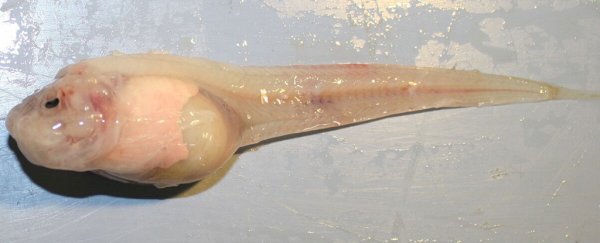Life's tough 8,000 metres (26,000 feet) beneath the ocean's surface. The pressure is 800 times that on the surface, the temperature is just above freezing, and there's zero light.
Which is a good thing for this new record-holder for 'world's deepest fish' – because the newly discovered Mariana snailfish (Pseudoliparis swirei) really isn't much to look at.
"They don't look very robust or strong for living in such an extreme environment, but they are extremely successful," says the University of Washington's Mackenzie Gerringer, lead author on the study that recently described the discovery.
Beauty isn't everything when you're living in a world of pure darkness, and it's not like we can show off our newest P. swirei additions to our games room aquarium.
But for such a hardcore creature, they do look kind of … well, soft.
To be fair, being soft and squishy is the best option for life deep down. Even animals that usually have calcium carbonate shells struggle to build them thanks to the intense pressure.
The big squeeze does some weird things to chemical reactions, which includes building proteins, which sets a limit on how deep most fish can survive.
The researchers pulled up 37 specimens of the snailfish in 2014 and 2017 using baited traps set between 6,898 to 7,966 metres (22,630 to 26,135 feet) inside the Mariana Trench, east of the Philippines.
The fish are slightly longer than a human hand, with translucent, scaleless skin that reveals pinkish organs beneath.
Snailfish in general aren't uncommon at depths around the world, where they cluster in groups to suck down shrimp and other crustaceans.
In fact, in 2008 a snailfish species called Pseudoliparis amblystomopsis was filmed at 7,700 metres (25,300 feet) in the Japan Trench, setting a previous record for world's deepest fish recorded on film.
"Snailfishes have adapted to go deeper than other fish and can live in the deep trenches," says environmental scientist Thomas Linley of Newcastle University.
But what would make a fish bother venturing into such an intense void? Turns out, life at the bottom isn't as bad as we'd imagine.
"Here they are free of predators, and the funnel shape of the trench means there's much more food," says Linley.
An analysis of this new discovery's DNA and a careful look at its anatomy confirms the Mariana specimens are a whole new species.
The researchers even used a CT scanner to map its insides, which confirms it's no less pretty under its skin.
Oh, and that green thing? That's its last lunch.
 (Adam Summers/University of Washington)
(Adam Summers/University of Washington)
Deepest fish doesn't equal deepest life, of course. Earlier this year researchers found evidence of life being spewed out of mud volcanoes inside the Mariana Trench, hinting at microbes 10 kilometres (6.2 miles) below the sea floor.
The trench bottoms out at roughly 11 kilometres (36,000 feet), but researchers don't hold out much hope for an even deeper species to be lurking out of sight.
Move over P. amblystomopsis, because this snailfish is sinking to new lows.
Check out the footage below, taking earlier this year at a depth of 8,178 metres (26,830 feet) by a Japanese research team.

(SOI/HADES/University of Aberdeen, Dr. Alan Jamieson)
This research was published in Zootaxa.
